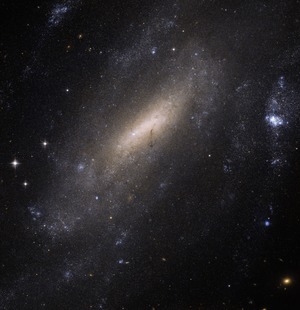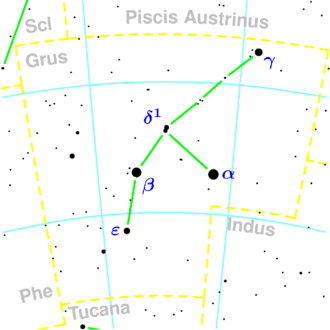IC 5201
| Galaxy IC 5201 |
|
|---|---|

|
|
| The galaxy IC 5201 as seen by the Hubble Space Telescope | |
| AladinLite | |
| Constellation | crane |
|
Position equinox : J2000.0 , epoch : J2000.0 |
|
| Right ascension | 22 h 20 m 57.4 s |
| declination | -46 ° 02 ′ 09 ″ |
| Appearance | |
| Morphological type | SB (s) cd / Sy2 |
| Brightness (visual) | 10.8 mag |
| Brightness (B-band) | 11.5 likes |
| Angular expansion | 8.5 / 3.9 |
| Position angle | 33 ° |
| Surface brightness | 14.5 mag / arcmin² |
| Physical data | |
| Redshift | 0.003052 ± 0.000007 |
| Radial velocity | 915 ± 2 km / s |
|
Stroke distance v rad / H 0 |
(40 ± 3) x 10 6 ly (12.2 ± 0.9) Mpc |
| history | |
| discovery | Joseph Lunt |
| Discovery date | 1900 |
| Catalog names | |
| IC 5201 • PGC 68618 • ESO 289-18 • IRAS 22179-4617 • 2MASX J22205743-4602090 • SGC 221754-4617.2 • | |
IC 5201 is a bar-spiral galaxy of the Hubble type SB (s) cd in the constellation Crane in the southern sky . It is estimated to be 40 million light years away from the Milky Way , has a diameter of around 110 million light years and is listed as a Seyfert 2 galaxy .
The galaxy was discovered casually in 1900 by the astronomer Joseph Lunt when he was looking for Theodor Brorsen's comets with an 18-inch telescope at the Royal Observatory near Cape Town .
Individual evidence
- ↑ a b c d NASA / IPAC EXTRAGALACTIC DATABASE
- ↑ a b c d e SEDS : IC 5201
- ^ Joseph Lunt : Notes on Nebulæ observed at the Royal Observatory, Cape of Good Hope . In: Monthly Notices of the Royal Astronomical Society . 62, 1902, pp. 468-470.
- ↑ Seligman
